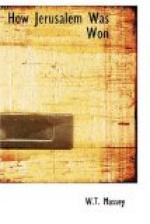An officers’ patrol swam the river one night, saw what the enemy was doing, and returned unobserved. A few nights afterwards two officers swam out to sea across the river mouth and crept up the right bank of the stream within the enemy’s lines to ascertain the locality of the ford and its exact width and depth. They also learnt that there were no obstacles placed across the ford, which was three feet deep in normal times and five feet under water after rains. It was obvious that bridges would be required, and it was decided to force the passage of the river in the dark hours by putting covering troops across to the northern bank, and by capturing the enemy’s positions to form a bridgehead while pontoon bridges were being constructed for the use of guns and the remainder of the Division.
Time was all-important. December and January are the wettest months of the season at Jaffa, and after heavy rains the Auja valley becomes little better than a marsh, so that a small amount of traffic will cut up the boggy land into an almost impassable condition.
The XXIst Corps’ plan was as follows: At dawn on December 21 a heavy bombardment was to open on all the enemy’s trenches covering the crossings, the fire of heavy guns to be concentrated on enemy batteries and strong positions in the rear, while ships of the Royal Navy bombarded two strong artillery positions at Tel el Rekket and El Jelil, near the coast. When darkness fell covering troops were to be ferried across the river, and then light bridges would be constructed for the passage of larger units charged with the task of getting the Turks out of their line from Hadrah, through El Mukras to Tel el Rekket. After these positions had been gained the engineers were to build pontoon bridges to carry the remainder of the Division and guns on the night of the 22nd-23rd December, in time to advance at daylight on the 23rd to secure a defensive line from Tel el Mukhmar through Sheikh el Ballatar to Jelil. On the right of the 52nd Division the 54th Division was to attack Bald Hill on the night of 21st-22nd December, and on the following morning assault the trench system covering Mulebbis and Fejja; then later in the day to advance to Rantieh, while the 75th Division farther east was to attack Bireh and Beida. This plan was given to divisional commanders at a conference in Jaffa on December 12. Two days later General Hill submitted another scheme which provided for a surprise attack by night with no naval or land artillery bombardment, such a demonstration being likely to attract attention. General Hill submitted his proposals in detail. General Bulfin gave the plan most careful consideration, but decided that to base so important an operation on the success of a surprise attack was too hazardous, and he adhered to his scheme of a deliberate operation to be carried through systematically. He, however, gave General Hill permission to carry out his surprise attack on the night of December 20, but insisted that the bombardment should begin according to programme at daylight on the 21st unless the surprise scheme was successful.




